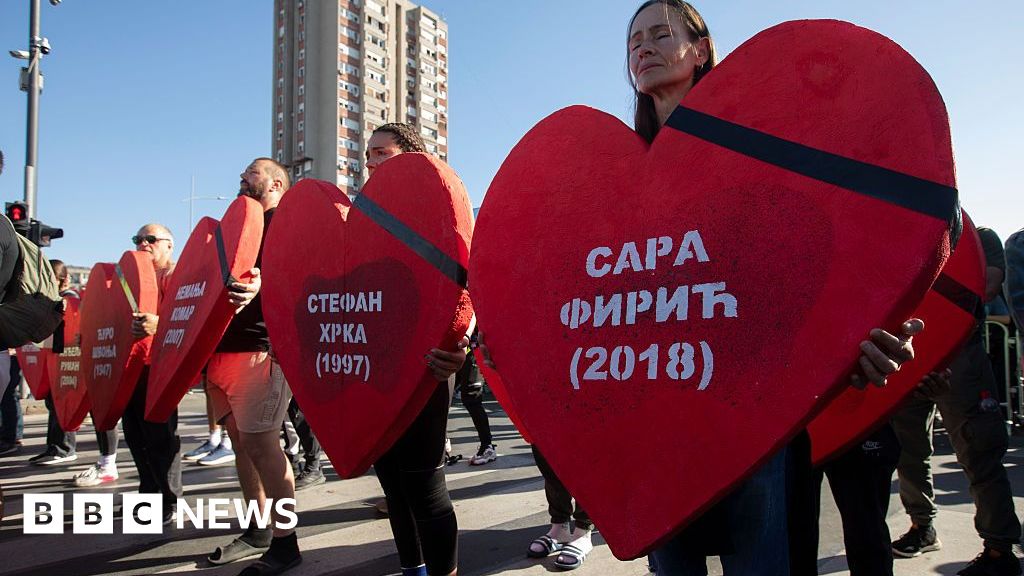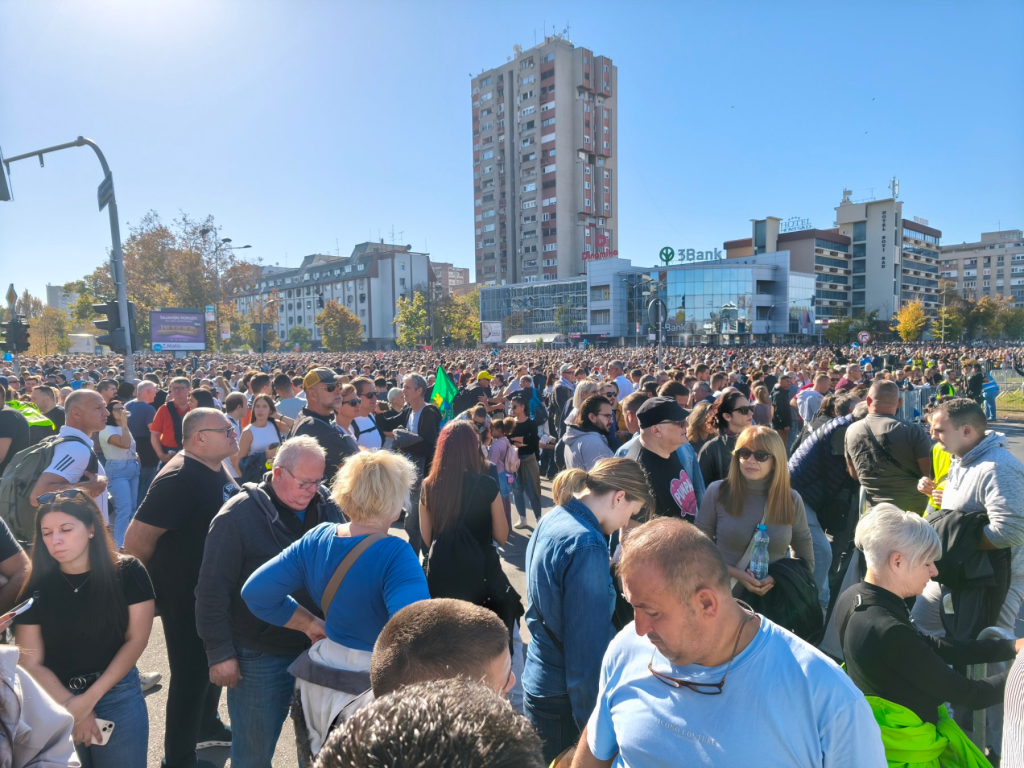Guy DelauneyBBC Balkans correspondent, Novi Sad
Watch: Video shows aftermath of railway station roof collapse in Serbia
A sea of people flowed along the roads leading up to Novi Sad railway station.
They came in their tens of thousands to remember the 16 people who died there this time last year, on another unseasonably warm and sunny autumn day.
The victims were standing or sitting underneath a concrete canopy at the recently-renovated facility, when it collapsed. The two youngest were just six years old, the oldest, 77.
Regular protests have rocked Serbia in the 12 months that have followed. But on Saturday morning, the huge crowd participated in an event that put the emphasis on quiet commemoration.
At 11:52 (10:52 GMT), the time of the disaster, they observed a silence for 16 minutes – one for each of the victims. Family members cried. One woman needed to be physically supported by men wearing the red berets of armed forces veterans.
After the silence, relatives laid flowers at the front of the station.
The rubble of the collapsed canopy has been cleared away, but otherwise the building appears to have remained untouched since the disaster.
Twisted metal protruding from the walls and broken glass still offer evidence of the catastrophe.
Anadolu via Getty Images
Huge protests have been held against the government since the accident
Novi Sad station was supposed to be a symbol of Serbia’s progress, under President Aleksandar Vučić’s Progressive Party. The country’s second city would be a key stop on the high-speed railway line whipping passengers from Belgrade to Budapest in less than three hours.
Vučić and Hungary’s Prime Minister Viktor Orban jointly opened the renovated facility in 2022. Its angular, Yugoslav-era form had been upgraded as part of the high-speed project.
But now, after another renovation and the disaster that followed, the station stands as the prime example of everything that is wrong in Serbia.
For the government’s flagship infrastructure project to prove deadly to its citizens was more than many people could bear. They took to the streets, carrying placards reading “corruption kills”.
University students quickly took leadership.
Getty Images
Families of those who died at Novi Sad laid flowers at the train station
Anti-government demonstrations are not exactly a novelty in Serbia, but in contrast to previous movements which fizzled out, the student-led anti-corruption protests have persisted.
“Every other protest movement was organised by political opposition parties and people in Serbia don’t trust them,” says Aleksa, a 23-year-old management student at Novi Sad University.
“We are the most trusted group in the country – that’s why, even though we have made mistakes, people believe in us.”
The students have shunned the opposition parties. After initially demanding accountability from the authorities, they are now calling for fresh elections.
They plan to submit a list of independent, expert candidates who could run a technocratic government. This would, they say, be the best way to rid Serbian institutions of the cronyism and corruption which they hold responsible for the railway station disaster.
In September, 13 people, including former construction, infrastructure and Transport Minister Goran Vesić, were charged in a criminal case over the collapse.
A resolution in the European Parliament last month called for full and transparent legal proceedings and an assessment “of potential corruption or negligence” – underlining the “need to examine more broadly the extent to which corruption led to the lowering of safety standards and contributed to this tragedy”.
The government has denied accusations of corruption.
Students are more trusted in Serbia than opposition parties, says Aleksa
The student protesters’ approach has gained the respect of some opposition leaders.
“They showed integrity and perseverance,” says Biljana Djordjević, an MP and co-leader of the Green-Left Front.
“The new generation have found their way of participating, that is the difference this time. They have cut across generations in the families, we always wanted them to be more vocal, and now they are.”
Political scientist Srdjan Cvijić, from the Belgrade Centre for Security Policy, believes the students have cut through in a way that Serbia’s opposition parties simply could no longer do.
“Until last year, the regime had been effectively managing to render traditional politics disgusting to the overall population,” he says.
“They haven’t managed to do so with the student movement and the result is that the student movement has managed to pierce into the traditional electorate of the ruling party in a way that nobody previously managed to do.”
Perhaps this explains a sudden change in tone from President Vučić. He has generally taken a combative line with the protesters, accusing them of attempting a “colour revolution” – the kind of popular movements that were behind pro-European protests which toppled governments in European countries in earlier years.
These changes in former Soviet republics in the early years of the 21st Century pushed the likes of Georgia and Ukraine in a pro-EU direction.
But on the eve of the commemoration, Vučić apologised for his fiery rhetoric towards protesters, claiming that he had “said some things that I am now sorry for saying”.
The students responded dismissively. They told the president, “You have blood on your hands.”
This day may have been about respect and remembrance. But the anger remains.





